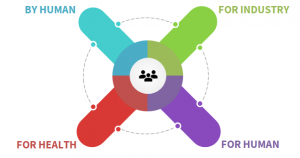AI by Human
One fundamental pillar of AiBy4 is the design of computational models that either explicitly mimic aspects of human intelligence, or implicitly learn such behaviors from interactions with humans during the design. Part of our intelligence being manifest through language, this axis includes the understanding and semantic analysis of human language.
Keywords: Human Inspired Algorithms, Human-AI interaction, Automatic Natural Language Processing, …
AI for Human
In order for current advances in AI to impact society positively, we need to study further, identify risks, raise awareness, and design strategies to improve such impact. To this end, Aiby4 will encourage topics that: improve AI’s usability in everyday life, design interpretable or explainable decision models, enhance conditions for the final user, and take into account the long term/societal effects. Aiby4 will equally promote the opening of a cross-disciplinary dialogue to discuss ethical and regulatory questions, such as the different types of bias present in AI solutions (e.g., data, experimental, intentional), the rights on personal data used to train them, or the laws that should rule their exploitation.
Keywords: Explainability, Equality, Regulatory, …
AI for Health
There is a high local demand for developing AI algorithms dedicated to analyzing medical data (images, clinical data, biological signals, genetic data, time-series, or heterogeneous combinations) to either improve the data quality, extract meaningful information or assist expert decisions. Today, the effective translation of AI methods to the clinical routine will depend upon finding answers to the needs for explainable algorithms, uncertainty measurements associated with every prediction, and methods that consider the interaction between AI-suggestions and human experts.
The above vital challenges will nourish the AI for Health axis of AIby4 around (but not limited to) the application domains of genomics, gastroenterology, cardiology, nuclear medicine, and rare diseases. The projects under this axis will also benefit from interactions within the i-SITE NeXT clusters: FAME and IBD.
Keywords: Precision medicine, Medical Imaging, Open Omics, Time-series and heterogenous data, …
AI for future industry
Aiby4 partners in this axis have the potential to contribute to the next industrial revolution at every scale, designing AI-based solutions to improve materials, components, manufacturing processes, and even cities. Data-driven AI approaches associated with fundamental physics principles promote the understanding and development of smarter materials, to be used in mechanical and civil engineering applications. At an intermediate scale, the fabrication of artificial neurons in silico or reconfigurable architectures for embedded AI requires dealing with material, software, and safety considerations. At a human scale, several advances such as the explosion of connected objects, the modeling of distributed agents architectures, and the cooperation between humans and machines are essential to increasing productivity, flexibility, and sustainability, and contribute to smart manufacturing. At the city scale, massive amounts of data call for scalable perception and scene understanding methods, capable of accounting for human expertise. Smarter cities also mean smarter mobility through the development of intelligent transport systems and the creation of autonomous and self-navigating robots/cars, without forgetting their ecological impact.
Keywords: Smart Manufacturing, Smart Cities, Smart Components, Smart Materials, …

